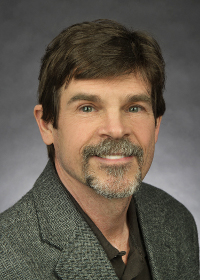Faculty
Professors | Lecturers | Affiliate | Postdocs | Emeritus

Professors

James Groome, Ph.D.
Professor
Neuroscience
Office: LS 136B
Research
Office: Life Sciences 140
We investigate ion channels of nerve and muscle fiber membranes that control electrical signaling. This work involves molecular biology and electrophysiology to understand the structure to function relations in ion channel function, and to determine the molecular basis of inherited mutations in the genes for these ion channels that cause specific channelopathies including myotonia and periodic paralysis.
Teaching
BIOL 4463 / 5563 - Human Pathophysiology
BIOL 4453 / 5553 - Foundations in Neuroscience
BIOL 4460 / 5560 - Neuroscience
PTOT 4402 / 5502 - Clinical Neuroscience
BIOL 4481 / 4482 - Independent Problems
BIOL 4491 / 4492 - Senior Seminar
Biographical Sketch
My laboratory studies ion channel proteins of nerve and muscle. We investigate the basis for inherited diseases of these genes, as channelopathy disorders such as myotonia and periodic paralysis. We also use electrophysiological and computational approaches to study the mechanisms of voltage-gating in ion channels. A new area of research is the study of neurotransmitter receptors with a focus on the role of neuronal, nicotinic acetylcholine receptors as a target of drug therapy in the treatment of Parkinson's disease.
Education
Ph.D. Zoology, University of New Hampshire, Durham, NH
B.A. Biology, Wake Forest University, Winston-Salem, NC
Postdoctoral fellow, Neuroethology, Utah State University, Logan, UT
Selected Publications
Bayless-Edwards L, Winston V, Lehmann-Horn F, Arinze P, Groome JR, Jurkat-Rott K. 2018. Nav1.4 DI-S4 periodic paralysis mutation R222W enhances inactivation and promotes leak current to attenuate action potentials and depolarize muscle fibers. Scientific Reports 8:10372. doi:10.1038/s41598-018-28954-5.
Groome JR, Moreau A, Delemotte L. Gating Pore Currents in Sodium Channels. 2017. In Handbook of Experimental Pharmacology: Sodium Channels and Related Diseases (Chahine M, ed).
Groome JR, Lehmann-Horn F, Jurkat-Rott K. 2014. Domain III S4 in closed-state fast inactivation: insights from a periodic paralysis mutation. Channels 8:467-471. doi 10.4161/19336950.2014.958924. PMID: 25483590
Groome JR, Lehmann-Horn F, Fan C, Wolf M, Winston V, Merlini L, Jurkat-Rott K. 2014. Nav1.4 mutations cause hypokalemic periodic paralysis by disrupting IIIS4 movement during recovery. Brain 2014; 137:998-1008. doi:10.1093/brain/awu015. PMCID: PMC3959555.
Sambasivarao SV, Roberts J, Bharadwaj VS, Slingsby JG, Hohleder C, Mallory C, Groome JR, McDougal OM, Maupin DM. 2014. Acetylcholine promotes binding of alpha conotoxin MII at alpha 3 beta 2 nicotinic acetylcholine receptors. Chem Biochem 15(3):B413-424.PMID:24420650.doi:10.1002/cbic.201300577
Groome JR, and Winston V. 2013. S1-S3 counter charges in the voltage sensor module of a mammalian sodium channel regulate fast inactivation. Journal of General Physiology 141:601-618. doi/10.1085/jgp.201210935. PMCID: PMC3639575
